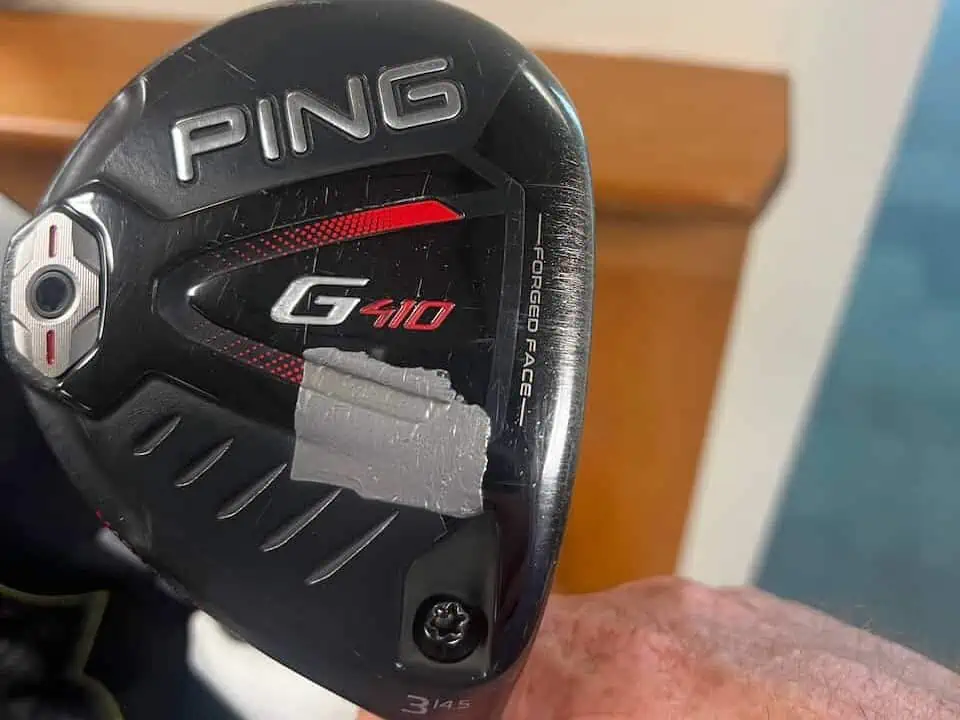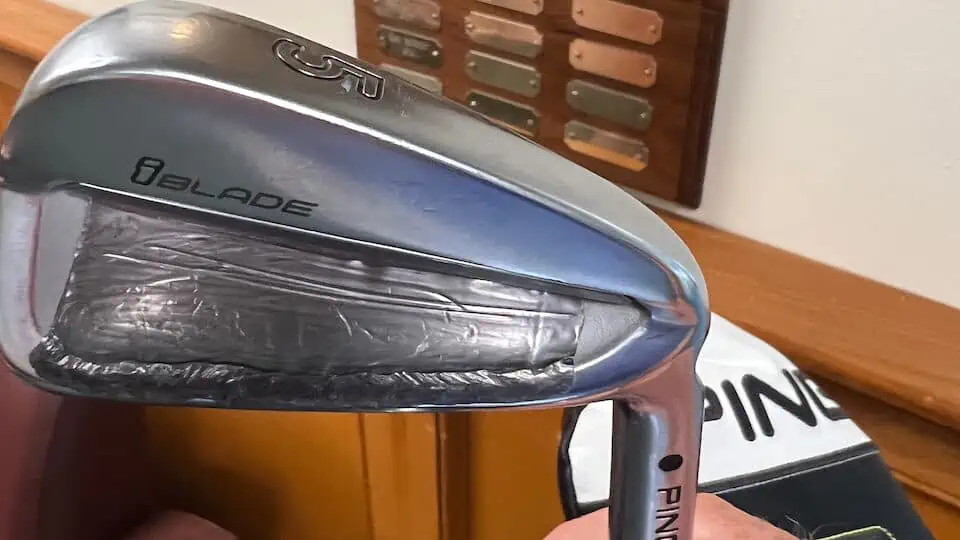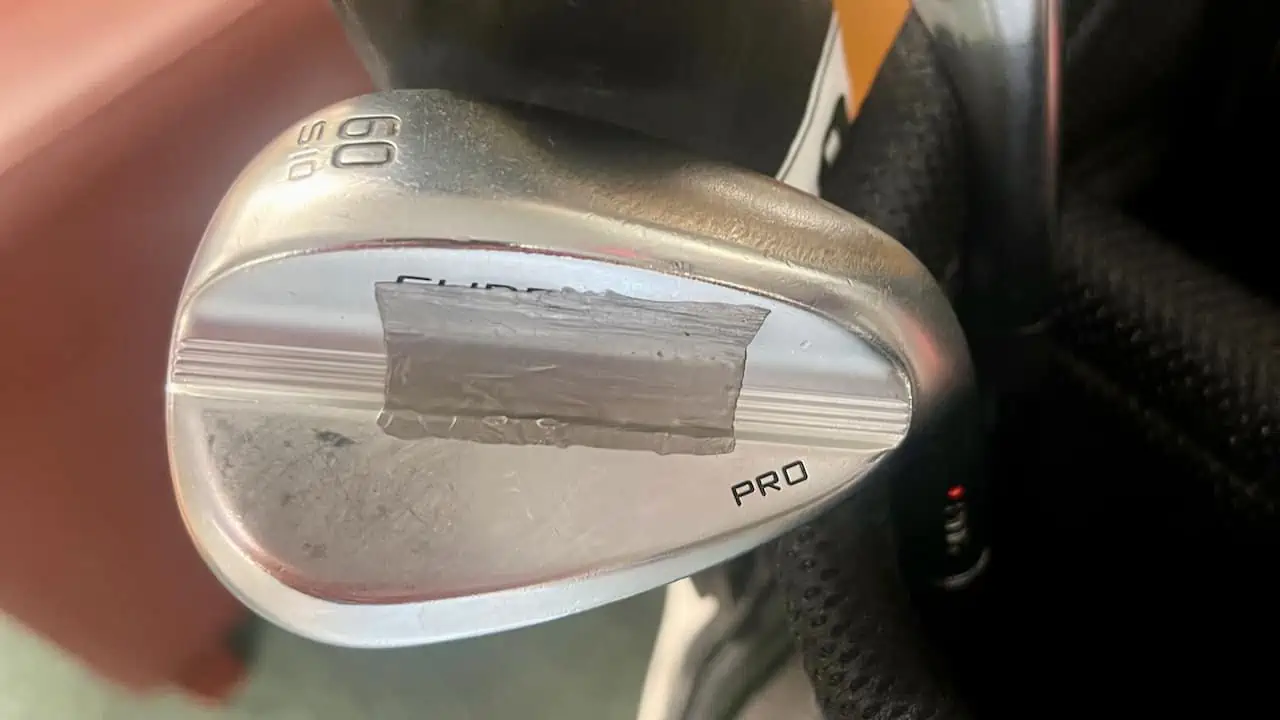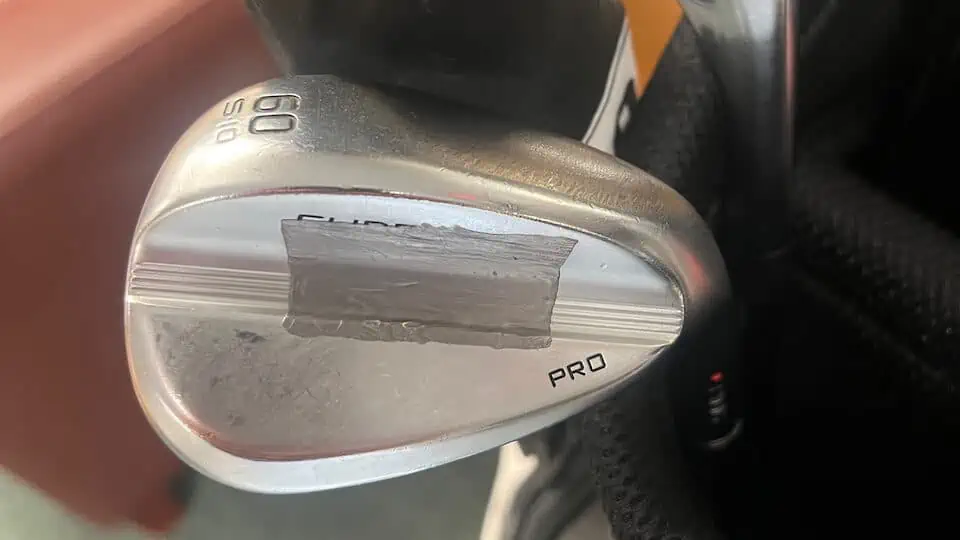Table of Contents
I’ve never really been into tinkering with my own golf clubs. Of course, I can change my grips, but when it comes to lie and loft changes, I leave that to the experts.
When I was 12, I was playing with a set of ladies’ irons that felt just a little too light for me. My uncle put a piece of lead tape on the bottom, and it actually helped me make more consistent contact.
As time has gone on, I’ve used lead tape quite a bit, mostly in short games and even iron play. If you are thinking golf club lead tape could help you, I’ll show you where to use it, how to use it, and why it works.
What is Lead Tape for Golf?
Lead tape for golf is a roll of high density lead tape (with some weight to it) that can be applied to a golf club head to change the swing weight of the club.
Golf clubs have weight in their club head, in the shaft, and in the grip.
The club’s swing weight is not just how heavy the entire club is, but instead the weight the club feels like it is when you swing it. This is a bit confusing, but a heavy club can feel lightweight depending on where the weight is located and how the club is balanced. The same can be said for light clubs feeling a little heavier.
In the end a golf club that weighs considerably more will almost always feel a little heavy.
However, my favorite use of lead tape for golfers is to make temporary adjustments to the golf clubs before deciding on permanent customizations. Add a little lead tape to experiment with performance before investing thousands in a new set of irons.
How Much Lead Tape To Use?
Before we get too involved in where the lead tape goes and how to apply it, I first want to address how much lead tape to use. Most amateur golfers like to exaggerate changes in the golf game, and you don’t want to do that with lead tape. You only need a small amount to change your swing weight.
A 1-inch piece of lead tape weighs around 2 grams and will change the swing weight of the club by one unit. Keep this in mind as you are applying lead tape; essentially, you will put on one piece at a time and experiment before adding more. It’s very easy to take on and off.
Where Do You Apply Lead Tape?

The location of the lead tape can impact the way your golf ball flies. The lead tape positioning is different depending on the golf club that you have in your hand.
Lead Tape on Driver & Fairway Woods
The driver and fairway woods have similar performance when adding lead tape. Don’t put the tape on the front of the driver or the top of the club head; this is only for the back, sole, heel, and toe.
As you will see when I explain more about lead tape for irons, wedges, and putters, the lead tape on your driver or fairway wood can impact the ball flight as well as the forgiveness of the club.
- To simply change the golf club weight or to make your driver or fairway wood more forgiving (and higher launching), place lead tape directly towards the back of the head in the center.
- For a more fade bias driver, place lead tape towards the toe.
- For a more draw bias driver or fairway, place lead tape towards the heel of the club.
- To lower spin and decrease overall forgiveness and increase workability move the lead tape on the sole of the club closer to the face.
Driver and fairway wood club heads are lighter than golf irons, so a piece of lead tape, in theory, will have a greater impact on performance.
Lead Tape on Irons

When you look at the size of a golf iron head, there is certainly not as much room to place the lead tape as there is with a fairway wood or driver. In addition, the head of your iron is already kind of heavy.
With a head weight of around 245 grams in your iron, putting a piece of lead tape that weighs 2 grams on the back is not really going to change ball flight.
It can change the way the club feels at impact, and that is enough for some golfers (especially those with more precision in their game).
Place the lead tape on your irons directly behind the sweet spot on the face of your club. If you have a cavity back iron, the lead tape will probably fit right in that cavity. Again, I would put one piece on at a time, check performance, and add more.
Lead Tape on Wedges
The wedges are similar to the irons in that you will not influence ball flight all that much by adding lead tape to the wedge. Instead, you can impact the overall feel.
I’ve always liked a little lead tape on my wedges. I feel like it helps me get that extra weight in the head that makes a strong descending blow and a little bit of heavier contact.
I place the lead weight on the back of the head of the wedge just like I do with an iron. There is really not too much room to put this tape, so keeping it centered is your best bet.
Lead Tape on Putter

The putter is similar to an iron in that it has a heavier head, and the lead tape won’t do all that much to influence the actual flight or direction of your putt. However, it can add a bit of weight to the head if that is something you prefer.
You have two options for where to put the lead tape on the putter head. You can put it on the back (behind the face of a blade putter) or directly on the sole of the putter. When you put lead tape on the sole of a driver or hybrid, it wears down because of turf interaction. With the putter, that won’t really be a concern.
Bernhard Langer has always put a little lead tape on his putter to help increase the club weight and fine-tune the feel that he was looking for.
Applying Lead Tape on Shaft
Lead tape on the golf shaft may seem like a really strange idea. I’ll admit that at first, I thought this might do something to damage a graphite shaft, but it doesn’t.
Putting lead tape on the golf shaft is actually a great way to test if you would benefit from having heavier golf shafts. I recommend putting eh tape on the back side of the club so that you are not looking at it.
Golf club shafts often come in weight increments of around 10 grams. A 5-inch piece of lead tape would give you about 10 grams of additional weight in the shaft, a great way to test before re-shafting your set.
How to Apply Golf Lead Tape
Where and how you apply the lead tape to your golf clubs will be specific to the club you are planning on changing, but here are the basic steps to apply lead tape effectively.
- It’s recommended to wear gloves when working with lead tape to avoid any risk or concern of lead poisoning.
- Measure and weigh the tape you want on your clubs; remember, a one-inch piece will be about 2 grams of additional weight.
- Use a razor blade or scissors to cut the piece that you need.
- Peel off the backing of the tape and apply to the golf club.
- Push down on the tape so that it is firmly in place.
- Wash your hands thoroughly after handling the lead tape, most golf professionals consider lead tape harmless, but it can’t hurt to give your hands a wash when you finish.
Use of Lead Tape by PGA Tour Pros
PGA Tour pros are club tinkerers. It’s not just because they are obsessed with the game of golf; it’s because they can actually feel the difference from one golf swing to the next after adding lead tape.
Phil Mickelson has been known to put lead tape on his putter shaft, which is a unique place to put it. Other golfers like John Daly and Jack Nicklaus have also used it.
Let’s just put it this way, if you found your way into the tour fitting van; there would be a lot of lead tape going around helping players tweak their golf clubs.
Types of Golf Club Lead Tape: Which is Best?
Fortunately, unlike other golf gear, equipment, and accessories, the type of lead tape you use on your golf clubs really doesn’t make that much of a difference.
I like the Brampton Lead Tape as it is the perfect width (1/2 inch size), and it seems to hold up well. The lead tape will come off after some time, so don’t be discouraged by the larger roll; you will eventually use it.
Frequently Asked Questions
How to use lead tape on golf clubs?
Use golf lead tape to increase the swing weight of a golf club. With the extra swing weight, you can feel the club head a bit more getting higher ball flight and gaining more consistency in your golf driver. It’s also used on putters and other clubs to adjust weight and and fine tune balance.
How much swing weight does lead tape add?
Most lead tape is ½ inch wide. If you use a ½ inch wide piece of one inch long tape, you will increase the weight in the club by about 2 grams and move it up one swing weight.
Is lead tape legal on golf clubs?
Lead tape is legal on golf clubs. However, you need to keep it away from the face of the clubs to keep your golf clubs conforming with the USGA.
Where to put lead tape on driver for distance?
The best place to put lead tape on a driver for distance is in the back center of the club head. This position will help to increase the launch of the driver, improve shot direction and, therefore, give you a little more yardage if you make a great swing.
Final Thoughts on Lead Tape for Golf Clubs
If you have a significant hook or slice with any club in your bag, you are still going to have to stick with the traditional method of working it out on the range. However, for slight modifications to swing weight and center of gravity, lead tape is a good solution.
I’ve successfully used lead tape to help me get a better feel and precision in my putting and even a little more stability in my fairway wood club head. The great tithing about golf club lead tape is that it’s a cheap way to experiment with feel and performance in your golf clubs.



